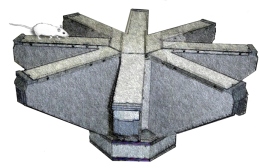Spatial Working Memory
Description
 In the Radial Arm Maze test, a rodent is placed in the center of a
maze. At the end of each arm are food pellets. To successfully
complete the task, the rodent must enter each arm and retrieve the food
pellets and use spatial cues in the room to remember which arms of the
maze it has previously explored to avoid re-entering the same arms.
Both 8- and 12- arm versions of the task are used. A computer operated
8-arm radial maze routinely used at the core facility is depicted above.
In the Radial Arm Maze test, a rodent is placed in the center of a
maze. At the end of each arm are food pellets. To successfully
complete the task, the rodent must enter each arm and retrieve the food
pellets and use spatial cues in the room to remember which arms of the
maze it has previously explored to avoid re-entering the same arms.
Both 8- and 12- arm versions of the task are used. A computer operated
8-arm radial maze routinely used at the core facility is depicted above.
Purpose
The radial arm maze task is used to assess spatial working memory and reference memory.
Non-Spatial Working Memory
Description
Non-Spatial Working Memory- Operant delayed-response tasks (i.e., usually lever pressing types of tasks similar to those originally developed by the famous experimental psychologist BF Skinner) are often used to assess working memory in rodents.
One example of an operant (working memory task) is the Delayed Stimulus Discrimination task (DSDT). This task employs modality discrimination and delayed response (light and tone stimuli and variable length delays, respectively).
Purpose
The subjects learn to discriminate between a light and a tone after a randomized (pre-programmed) delay interval in order to obtain a food pellet reward by pressing the correct lever (e.g., light-go right, tone-go left). Performance of the task is sensitive to both amnestic agents and memory enhancing drugs.